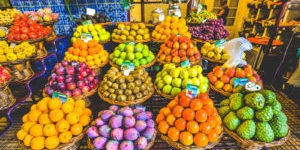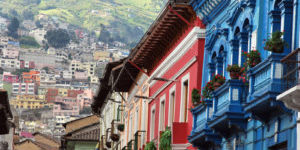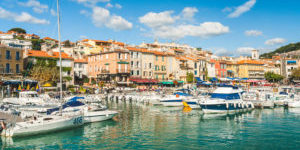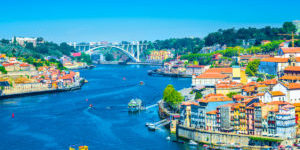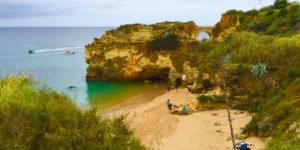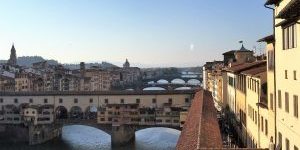In this Florence City Guide you’ll find my personal best Florence travel tips for how to experience Florence’s major attractions, iconic culture, and magical lifestyle …
At first glance, I swore that time had morphed backwards and that the leather-aproned gentleman before me was Pinocchio’s father. I had stumbled upon a bookbinder’s shop in Oltrarno, Florence’s ‘other side’, where Michelangelo and other Renaissance Masters had lived and apprenticed back in the day.
Convinced he was definitely not Master Geppetto, I gladly accepted the bookbinder’s kind invitation to browse his centuries-old work shop, one of the many iconic artisan shops lining the cobbled streets and passages of Florence’s left bank.
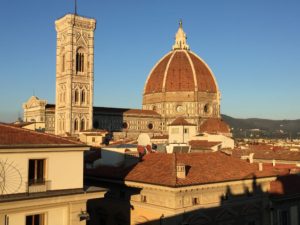
Florence City Guide: Best Places to Live Renaissance History
Birthplace of the Renaissance and the Capital of Tuscany, Florence embodies the essence of cultural immersion and authentic experiences. Boasting an exceptionally rich and unique history, Florence thrives today as a vibrant renaissance-era city in modern day where you can live yesterday’s history, today.
If drop-dead gorgeous surroundings, engaging with friendly locals, and abundant exploration opportunities are part of your dream travel adventure, take a close look at what Florence, and all of Tuscany, offer you – for memories that promise to endure a lifetime.
Florence ranks as a top destination for visitors drawn to the old city’s UNESCO World Heritage status and Renaissance Masterpieces from Michelangelo, Raphael, Da Vinci, Giotto, Brunelleschi, and Vasari which exquisitely decorate world renowned museums, churches, monasteries, palazzos, piazzas, bridges, fountains, convents, and sculpted gardens.
From the top of any nearby Tuscan hillside or resident medieval guard tower, you can gaze upon the majestic Renaissance panorama below reflecting Florence’s ageless beauty that literally steals your breath away.
What you see is a magical cityscape divided by the Arno River and ornately adorned with the Palazzo Pitti, the Palazzo Vecchio, the soaring domed Duomo, stately centuries-old bridges gracing the river, the old city wall, the verdant Boboli and Bardini Gardens, the Uffizi Galleries, the Logia dei Lanze outdoor museum in Piazza Signoria, colorful café-lined cobbled streets, and an array of treasure troves – all awaiting your discovery.
As you’ll see in the Florence City Guide, to best absorb Florence’s deep history and heritage, it’s important to explore both sides of the Arno River – the right bank with the looming Duomo (Cathedral) and majority of Florence’s famous museums, as well as the left bank, populated with myriad artisan and antique shops to browse in a lower-key, tradition-centric environment.
Both sides of the river claim famous attractions, but also significant are the hidden gems sprinkled throughout, worthy of discovery. These elusive treasures can be out of the way family eateries serving traditional foods, secret palatial gardens, revered artwork by the era’s Masters hidden in plain sight, and discreet architecture with a storied past.
Florence City Guide: Insights for Living the ‘Dolce Vita’
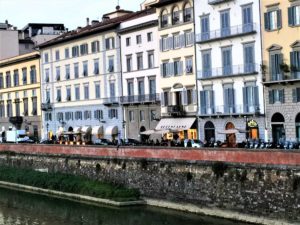
Florence excels at the ‘la Dolce Vita’ way of life, making it the perfect spot to enjoy the fabled city like a local. The Florentines make it easy, welcoming, and exciting to linger longer than a typical visit. Indeed, they hope you stay long enough to get to know them and vice versa. (Don’t hesitate to try out even a bare minimum of Italian with your neighbors and shop keepers, they will appreciate the effort – even if it’s just the day’s greeting (ciao) and good-bye (addio or ciao).)
Florentine Apartment Stays
Staying in an apartment automatically immerses you into the Florentine way of life – ‘la Dolce Vita’. Renting a city center apartment where you can walk everywhere and have a set of neighborhood shops at your disposal for banking, shopping, and dining, sets the stage for a grand experience.
By adopting some of the Florence City Guide tips about living the local lifestyle, you can daily engage with shop keepers and neighbors who are more than willing to steer you towards the best and cheapest of everything – fresh produce, open air markets, restaurants, gelateria, pharmacies, happy hours spots, tourist sights, and more.
Having an apartment with a kitchen, more living room than a comparable hotel, and a range of amenities (WiFi, a/c, TV, etc.) can be found in the heart of old town or in a near suburb within walking distance to the historic center, river, cafés, shopping areas, and restaurants.
My apartment was ideally located in a popular area of lovely apartment buildings with antique shops as my neighbors. The river, lined with outdoor cafés, wine bars, leather stores, jewelry shops, and hotels was a 3 minute walk away. The historic center was a 15 to 20 minute stroll along the river or via the narrow winding cobbled streets, and Oltrarno was just one bridge crossing away.
For the best Florence neighborhoods, see here.
Tuscan Food Scene
I included this topic in the Florence City Guide since quality and abundant food and drink are such an important part of Florence’s “Dolce Vita”. Florence restaurants, cafés trattorias, gelaterias, and wine bars dominate the city squares and many streets throughout the city. If you’d like better quality and better value for your dining, it’s a good idea to move 3 to 4 streets away from any major tourist attraction to enjoy a more traditional Florentine meal.
Perhaps one of the best tips offered by the Florence City Guide is about ‘happy hour’ time in the city. It’s always fun to participate in Florence’s “Aperitivo” which is offered at happy hour by many establishments. Popular with the locals and expats, it’s a sunset event where your beverage buys you access to delicious (and filling) traditional appetizers ‘crostini’ and small plates that often suffice for a light dinner.
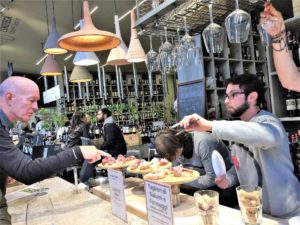
Neighborhood Mom & Pop shops provide farm to table produce daily to their neighbors and can be found just about everywhere.
Open air markets like in the Santo Spirito neighborhood and covered markets like the bustling Mercato Centrale in the San Lorenzo neighborhood, have more variety and are local favorites. At the Mercato Centrale you can even enjoy a meal, taste some tapas and sip local wine.
Also found throughout the city are gelaterias where you can purchase wonderful gelato. I suggest you always opt for “artisinal” authentic gelato rather than the extremely bold colored gelato found in tourist areas.
For the 6 best artisinal gelato (handmade ice cream using fresh ingredients, faithful to tradition) in Florence (my faves), see here.
Shopping
You’ll find upscale shopping streets downtown and outdoor market places on the cobblestone streets selling rows of leatherwork and other Florentine items like clothing, scarves, food stuffs, and artifacts. Almost every piazza is lined with outdoor cafes and variety shops as well as portable merchant kiosks for browsing and bartering.
A Typical Florentine Day
Most mornings, I made a beeline from my old town apartment on Via Fossi to a favorite coffee bar at Piazza Santa Maria Novella for that first espresso and croissant of the day. I could chose to stand at the coffee bar with the Carabinieri who frequented the shop (always leaving their motorcycles just outside the door, ready and raring to go), or sit outside observing the typical morning hustle & bustle.
Afternoons were for city-wide exploration. If I had a museum in mind, I also explored the surrounding area looking for an interesting place for lunch and shopping. Or, there might be a discovery theme like wandering an unfamiliar neighborhood to find gelateria shops worthy of adding to my favorites list. These exploratory afternoons were mostly “unscripted”, as I leisurely walked either side of the river to observe different vistas, tourist sights, hidden gems, centuries-old architecture, eateries, piazzas and shopping.
Evenings normally included a light dinner in my apartment or at a neighborhood café, unless I was enjoying a happy hour with friends that night. With my apartment only steps from the river, I often strolled along the riverbank towards old town watching the light from old style lamp posts playfully dance on the river, illuminating the bridges – an experience that always drew other evening walkers as well.
Florence City Guide: Tips on Living Like a Local Under the Tuscan Sun
What to See & Experience
Immersed in the middle of exquisite Renaissance history, you can imagine living during the Renaissance era (14th to 17th century) when there was a resurgence of classical art, architecture, literature, and learning originating in Florence and later spreading throughout Europe. In Florence today, you’ll feel like you’re frozen in time, witnessing first-hand the daily to and fro of the Renaissance town as you meander the same narrow cobbled streets that Michelangelo, Leonardo and Donatello tread.
You’ll discover history as you pass through ancient historic areas where, for example, transient Etruscans had a marketplace and Roman settlers built the Ponte Vecchio. Indeed, every inch of the historic center oozes the city’s incredible storied past.
The Tuscan city is truly a magical Renaissance theme park, elegantly crafted over the ages, where you can wander curvy passages and streets (with some only wide enough for a horse, let alone a carriage) and be spontaneously greeted by some enigmatic engraved religious or political symbol, stumble upon a picturesque marble statue, encounter a handsome medieval structure, or spot an historic artifact in plain sight – all in one afternoon. Florence is one city where it’s impossible to lack for things to see and experience.
Self-Guided ‘Don’t Miss’ Discovery Tours
Brimming with so many amazing things to see and experience, the iconic Tuscan city is nonetheless easy to navigate by foot on your self-guided discovery walks. A veritable feast for the senses, they’re a great way to discover the Renaissance past, as you wander cobblestone streets where Leonardo, Michelangelo, and other Renaissance Masters lived and practiced their craft.
Here are just a few of this Florence City Guide’s ‘don’t miss’ sights and activities for your Florence discovery walks …
The historic center, dominated by the Duomo (Florence’s cathedral), is the city’s beating heart. Thanks to my city-center apartment, old town was a short 15 minute walk away – whether I stepped left or right out the front door, determined which discovery route I took to the Duomo. The historic center was frequently my first stop of the day.
I took time to savor a coffee at one of the cafés tucked in below the looming Duomo, and basked for a while in the majesty of my distinguished surroundings – the Duomo, the Baptistery, and the Bell Tower – before venturing beyond the ancient square. Never tiring of the enchanted Piazza del Duomo, it was the perfect spot to start many of my walking adventures.
For a local-guided city orientation walk, see here.
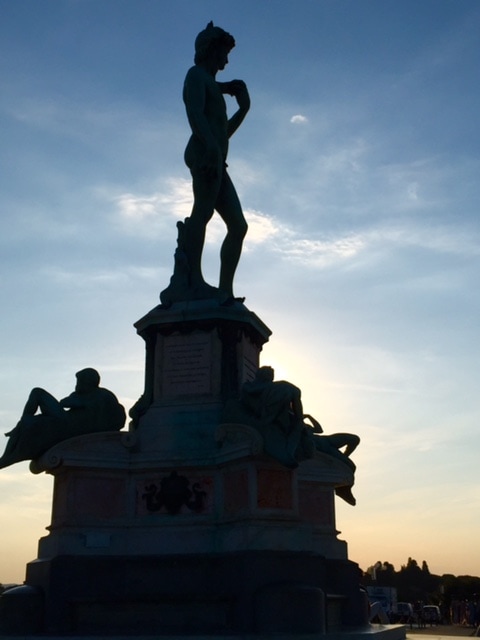
Piazzale Michelangelo, named for Michelangelo’s ‘David’ statue reproduction standing in the center of the observation terrace, is famous for jaw-dropping panoramic views cast over all of Florence, especially heavenly at sunset.
The 1 ½ to 2 hrs. stroll zig-zags upward through lush flowering gardens with gorgeous views around every bend in the trail. If the walk itself doesn’t take your breath away, the views when you get to the top certainly will!
As you walk, you’ll find intermittent cascading staircases making the ascent easier. However, if you want to avoid the uphill walk, you can take a bus to the top and then walk down. At the piazzale, you can linger at one of the welcoming cafés, browse outdoor handicraft vendors, and pleasantly while away the day.
Your Piazzale Michelangelo walking tour could include a stop at the Bardini Museum and Gardens where you can meander for a couple hours. Another option would be to continue upwards from Piazzale Michelangelo arriving at the Romanesque San Miniato al Monte Basilica (built between 11th and 13th centuries), one of the highest spots in the city with unparalleled vistas.
If you prefer a tour designed by local experts, see here.
If you’d like to tour by bicycle, see here.
Piazza della Signoria, halfway between the Duomo and Arno River, served as the city’s political center in medieval times . The bustling L-shaped square, rimmed by restaurants, museums, shops, and wine bars continues to be one of the most popular gathering places for locals and tourists alike who are drawn by the piazza’s distinct grandeur, awash in history, art, and architecture.
You’ll find here, the opulent Palazzo Vecchio (formerly the town hall and secretly connected via the infamous Vasari Corridor to the Pitti Palace across the river). Also here, is the world-renowned Uffizi Gallery showcasing spell-binding masterpieces by Michelangelo, Botticelli, Leonardo da Vinci, Raphael, and Caravaggio, and a personal favorite, the amazing Logia dei Lanze (outdoor museum), overlooking the handsome square.
If you’d like to avoid long queues for entrance to the Uffizi Gallery and other museums, you can purchase “skip the line” museum tickets in advance, see here.
Galleria dell’Accademia is where you’ll find Michelangelo’s original ‘David’ as well as other master works by him and other Renaissance Masters. If a Michelangelo fan, you can expand your discovery tour to other places where his artwork is displayed – such as the Casa Buonarroti, Santo Spirito Church, Bargello Museum, Accademia, Uffizi, Palazzo Vecchio, San Lorenzo Church, Opera del Duomo Museum and Palazzo Medici.
For passes to any of the museums, see here.
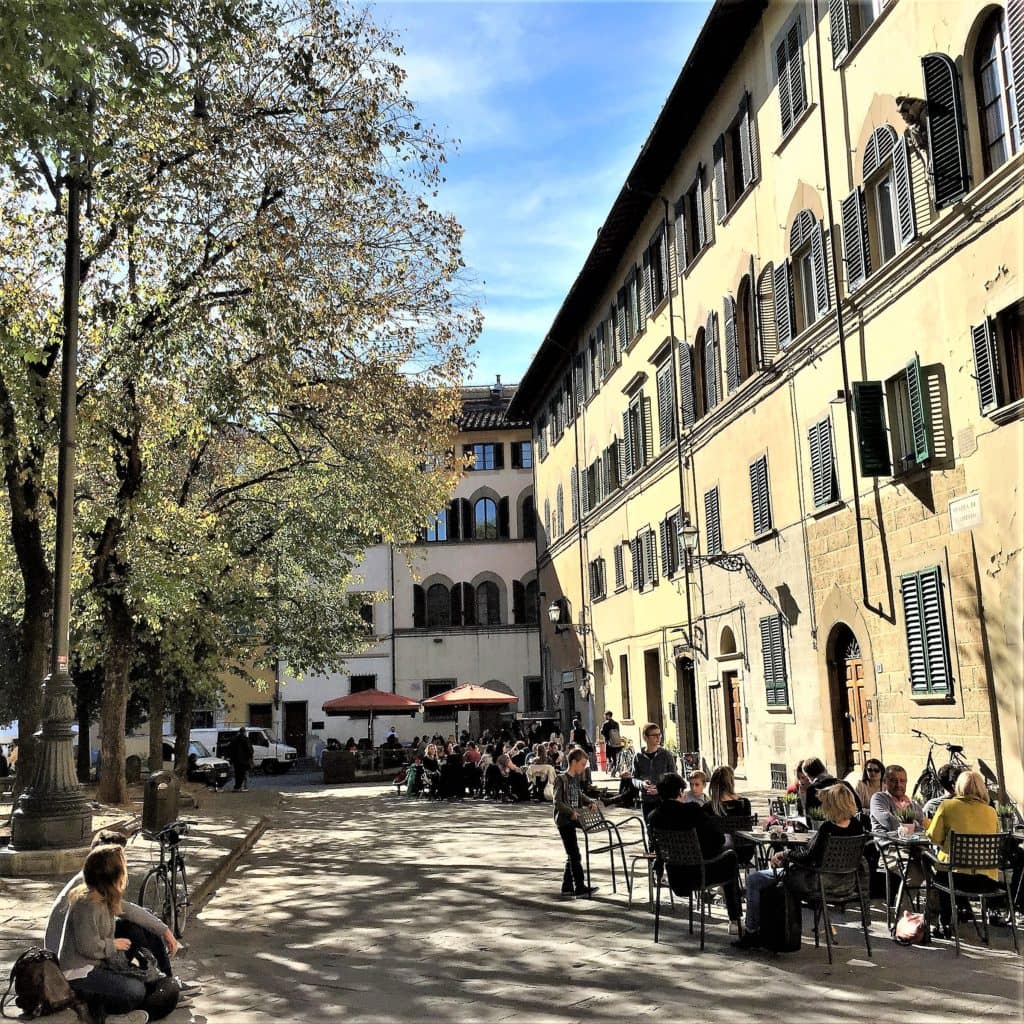
For Tuscan Cuisine Exploration, a good place to start is the Santo Spirito Piazza in Oltrarno (Florence’s left bank), Florence’s more local-centric side of the river, and just a short bridge crossing from old town. Very popular with locals, you’ll find large wooden tables with benches outside at a few of the traditional eateries in the lively café-lined square.
A favorite with locals, students, and tourists alike, is the Santa Croce area (on the right bank) where many cafés offer a generous-portioned happy hour buffet of typical crostini (Italian appetizers) and small plates of traditional delicacies.
A lesser known area but very popular with Florentines is the San Niccolo laid-back district where you can spend the day in this tucked-away corner of Florence cruising funky energetic eateries and touring nearby sights, including San Niccolo’s guard tower and the Bardini Gardens . San Niccolo is on the way to Piazzale Michelangelo and San Miniato al Monte so it makes an ideal spot to have a meal or go for happy hour.
For authentic Florentine gelato stop at one of the neighborhood gelaterias along your walk – many will advertise as “authentica” or “artisanal”.
For my 6 gelateria personal favorites, see here.
To explore traditional eateries or learn how to cook Tuscan food, see here.
To take a Tuscan Food cooking class or for wine tasting, see here.
Churches as Museums are sprinkled throughout the city. You’ll find churches that have a painting, fresco, or sculptured masterpiece from one of the Renaissance Masters. This is expected in the larger Basilicas like San Lorenzo and Cathedrals but many times masterpieces are unexpectedly found in smaller churches, convents, or monasteries such as those paintings and frescoes found at Santa Maria Novella.
The cradle of the Renaissance, works of art by the Renaissance Masters were commissioned by churches, chapels, monasteries and rich families such as the Medici. To view these masterpieces, it’s necessary to visit the church, monastery, or chapel for which the work was created. In each “parish”, expect plenty of spontaneous discovery as you wander from famous churches to café rimmed piazzas, beautiful gardens, antique shops, and gelaterias.
Cross Ponte Vecchio to the Pitti Palace, to enjoy not only what’s inside the elegant Pitti Palace but also to stroll the beautiful Boboli Gardens spread out in the palace’s backyard. Take some time to explore the fabled streets of Oltrarno around the palace which are chock-a-block with antique stores and artisanal shopping curiosities. It’s also a popular area for browsing endless leather shops lined up along the Via De Guicciardini leading to Pitti Palace.
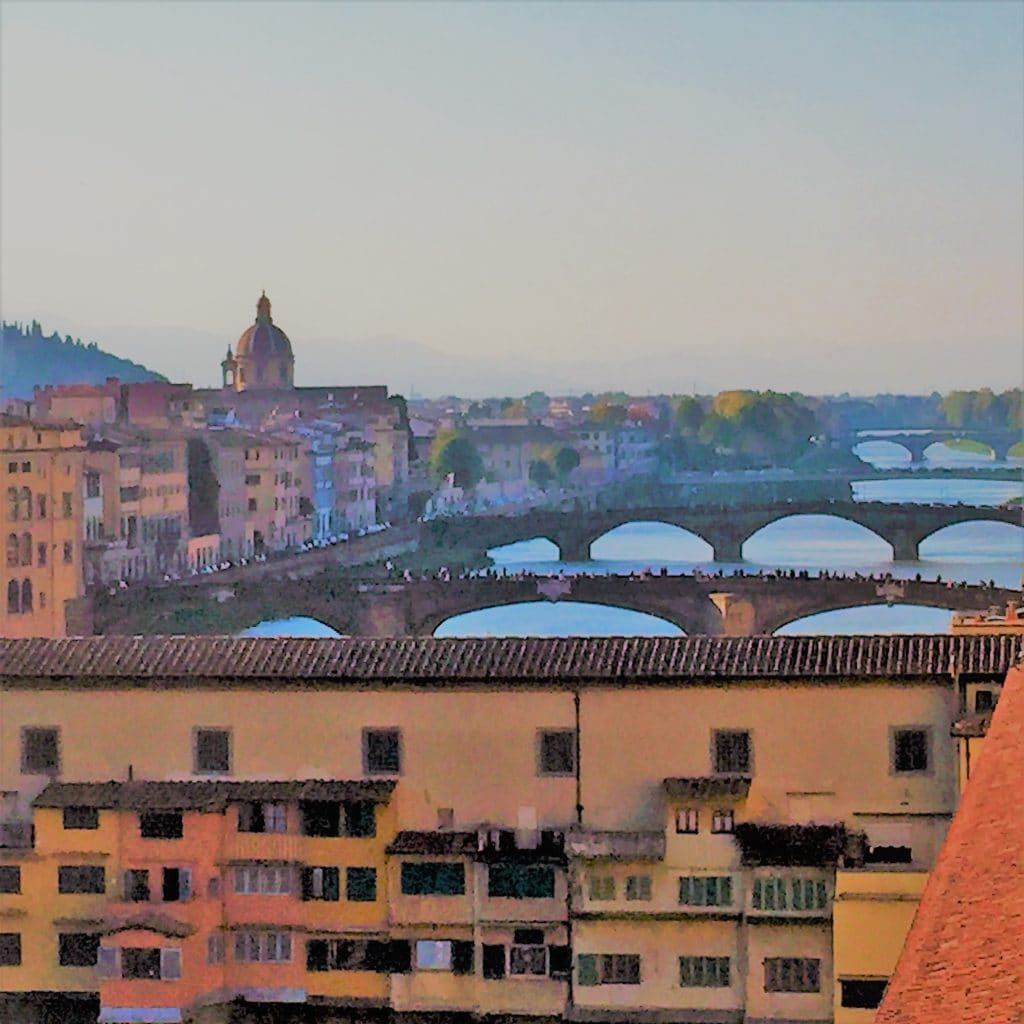
Walk along the six bridges of Florence from Ponte Niccolo to Ponte Amerigo Vespucci which beckon you to experience their beauty as you wander their diverse neighborhoods on both sides of the river.
Mornings you’ll spot walkers and runners on the pedestrian walk overlooking the river. Whenever heading out on a discovery walk, I inevitably included a short walk along the mesmerizing river to glimpse a canoe rower or barchetto (small traditional wooden boat similar to a gondola) gliding serenely from bridge to bridge.
Built by Romans, the iconic pedestrian-only Ponte Vecchio is the oldest bridge in Florence. It was spared the WWII bombings but all the rest were destroyed and were reconstructed afterwards. It’s the only bridge with jewelry shops and where the infamous secret passageway, Vasari Corridor, was built over the shops by Vasari for Duke Cosimo I de’ Medici in 1565 linking the Palazzo Vecchio to the Pitti Palace.
For canoe or barchetto tours on the Arno river, see here. I hope this Florence City Guide at least wets your appetite enough to consider an adventure to this unique Tuscan City.
Related Articles for Florence Travel Tips
Where to Stay in Florence
Best Experiences in Italy
Eat Like a Local in Florence
Plan Your Trip

